nn.Sequential
源码位置:./torch/nn/modules/container.py
# 查看torch位置
>>> import torch
>>> torch.__file__
# container.py包含内容
# 都继承自nn.Module类
# class Sequential(Module)
# class ModuleList(Module)
# class ModuleDict(Module)
# class ParameterList(Module)
# class ParameterDict(Module)
1 nn.Sequential用法及源码
函数包括:
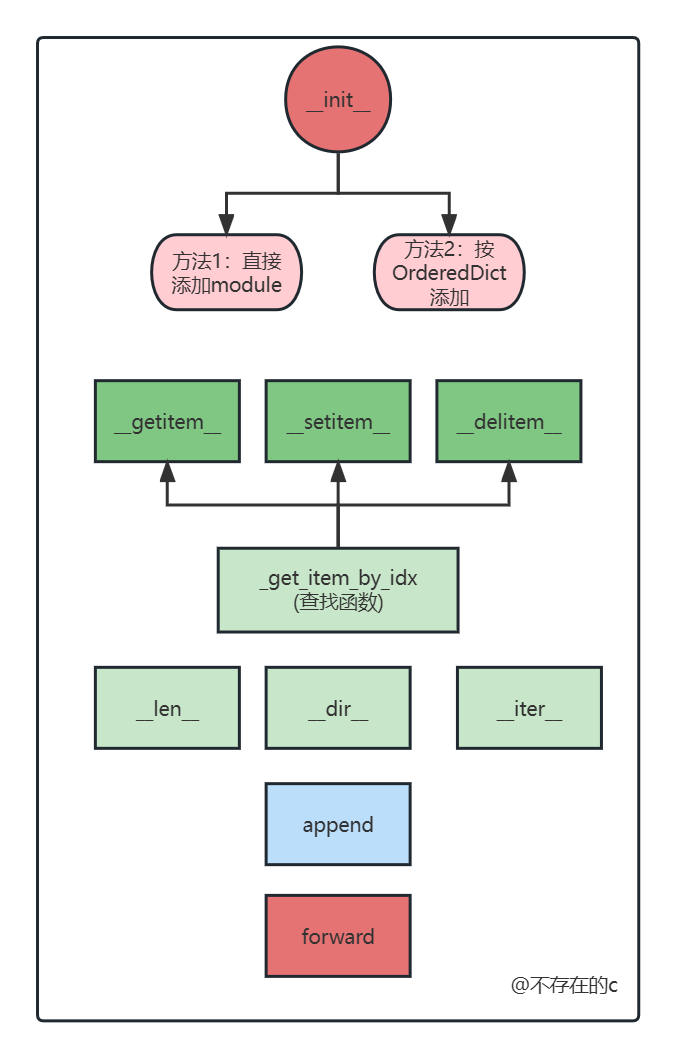
1.1 初始化方法_init_
_init_ 用法:
# 用法1 传入OrderedDict
model = nn.Sequential(OrderedDict([
('conv1', nn.Conv2d(1,20,5)),
('relu1', nn.ReLU()),
('conv2', nn.Conv2d(20,64,5)),
('relu2', nn.ReLU())
]))
# 用法2 直接添加module
model = nn.Sequential(
# 二维卷积
nn.Conv2d(1,20,5),
nn.ReLU(),
nn.Conv2d(20,64,5),
nn.ReLU()
)
源码:
# 有序 容器
class Sequential(Module):
_modules: Dict[str, Module] # type: ignore[assignment]
@overload
def __init__(self, *args: Module) -> None:
...
@overload
def __init__(self, arg: 'OrderedDict[str, Module]') -> None:
...
def __init__(self, *args):
super(Sequential, self).__init__()
# 方法1.如果传入参数为OrderedDict类型 则遍历OrderedDict(包含key) 添加模块
if len(args) == 1 and isinstance(args[0], OrderedDict):
for key, module in args[0].items():
self.add_module(key, module)
# 方法2.不是OrderedDict 直接添加模块(模块的key默认是数字0,1,2...)
else:
for idx, module in enumerate(args):
self.add_module(str(idx), module)
1.2 _getitem_,_setitem_,_delitem_
_getitem_
_setitem_
_setitem_
用法:
# getitem
# 1.如果是用OrderedDict创建的 用key获取
>>> model
Sequential(
(conv1): Conv2d(1, 20, kernel_size=(5, 5), stride=(1, 1))
(relu1): ReLU()
(conv2): Conv2d(20, 64, kernel_size=(5, 5), stride=(1, 1))
(relu2): ReLU()
)
>>> model.conv1
Conv2d(1, 20, kernel_size=(5, 5), stride=(1, 1))
>>> model.relu1
ReLU()
>>>
# 2.如果是直接创建的 用index获取
>>> model
Sequential(
(0): Conv2d(1, 20, kernel_size=(5, 5), stride=(1, 1))
(1): ReLU()
(2): Conv2d(20, 64, kernel_size=(5, 5), stride=(1, 1))
(3): ReLU()
)
>>> model[0]
Conv2d(1, 20, kernel_size=(5, 5), stride=(1, 1))
>>> model[1]
ReLU()
>>>
源码:
# 调用了_get_item_by_idx函数
def __getitem__(self, idx) -> Union['Sequential', T]:
# OrderedDict取值方式
if isinstance(idx, slice):
return self.__class__(OrderedDict(list(self._modules.items())[idx]))
# 按传入索引取值
else:
return self._get_item_by_idx(self._modules.values(), idx)
# 查找函数 被调用
def _get_item_by_idx(self, iterator, idx) -> T:
"""Get the idx-th item of the iterator"""
size = len(self)
idx = operator.index(idx)
if not -size <= idx < size:
raise IndexError('index {} is out of range'.format(idx))
idx %= size
return next(islice(iterator, idx, None))
# setitem
# 修改已经存在模块的信息
# 以下代码将原来的0模块卷积核大小由5 × 5改为3 × 3
>>> model
Sequential(
(0): Conv2d(1, 20, kernel_size=(5, 5), stride=(1, 1))
(1): ReLU()
(2): Conv2d(20, 64, kernel_size=(5, 5), stride=(1, 1))
(3): ReLU()
)
>>> model[0] = nn.Conv2d(1,20,3)
>>> model
Sequential(
(0): Conv2d(1, 20, kernel_size=(3, 3), stride=(1, 1))
(1): ReLU()
(2): Conv2d(20, 64, kernel_size=(5, 5), stride=(1, 1))
(3): ReLU()
)
# 源码
def __setitem__(self, idx: int, module: Module) -> None:
key: str = self._get_item_by_idx(self._modules.keys(), idx)
return setattr(self, key, module)
# delitem 删除现有的module
# 以下代码演示删除原来的0模块
>>> model
Sequential(
(0): Conv2d(1, 20, kernel_size=(3, 3), stride=(1, 1))
(1): ReLU()
(2): Conv2d(20, 64, kernel_size=(5, 5), stride=(1, 1))
(3): ReLU()
)
>>> del model[0]
>>> model
Sequential(
(1): ReLU()
(2): Conv2d(20, 64, kernel_size=(5, 5), stride=(1, 1))
(3): ReLU()
)
# 源码
def __delitem__(self, idx: Union[slice, int]) -> None:
# 有子模块
if isinstance(idx, slice):
for key in list(self._modules.keys())[idx]:
delattr(self, key)
else:
key = self._get_item_by_idx(self._modules.keys(), idx)
delattr(self, key)
1.3 输出信息 _len_,_dir_
用法:
>>> model
Sequential(
(1): ReLU()
(2): Conv2d(20, 64, kernel_size=(5, 5), stride=(1, 1))
(3): ReLU()
)
>>> len(model)
3
>>> dir(model)
['T_destination', '__annotations__',..., 'training', 'type', 'xpu', 'zero_grad']
源码:
def __len__(self) -> int:
return len(self._modules)
# 返回当前范围内的变量、方法和定义的类型列表
def __dir__(self):
keys = super(Sequential, self).__dir__()
keys = [key for key in keys if not key.isdigit()]
return keys
1.4 迭代器 _iter_
用法:
>>> model
Sequential(
(1): ReLU()
(2): Conv2d(20, 64, kernel_size=(5, 5), stride=(1, 1))
(3): ReLU()
)
>>> for i in iter(model):
... print(i)
...
ReLU()
Conv2d(20, 64, kernel_size=(5, 5), stride=(1, 1))
ReLU()
>>>
源码:
def __iter__(self) -> Iterator[Module]:
return iter(self._modules.values())
1.5 添加module append方法
用法:
>>> model
Sequential(
(0): Conv2d(1, 20, kernel_size=(5, 5), stride=(1, 1))
(1): ReLU()
(2): Conv2d(20, 64, kernel_size=(5, 5), stride=(1, 1))
(3): ReLU()
)
>>> model.append(nn.Conv2d(1,20,3))
Sequential(
(0): Conv2d(1, 20, kernel_size=(5, 5), stride=(1, 1))
(1): ReLU()
(2): Conv2d(20, 64, kernel_size=(5, 5), stride=(1, 1))
(3): ReLU()
(4): Conv2d(1, 20, kernel_size=(3, 3), stride=(1, 1))
)
源码:
def append(self, module: Module) -> 'Sequential':
self.add_module(str(len(self)), module)
return self
1.6 前向传播函数 forward方法
用法:
模型会自动调用;
# 前向传播
model(data)
# 而不是使用下面的
# model.forward(data)
源码:
# input依次经过每个module
def forward(self, input):
for module in self:
input = module(input)
return input
2 nn.ModuleList用法及源码
函数们:
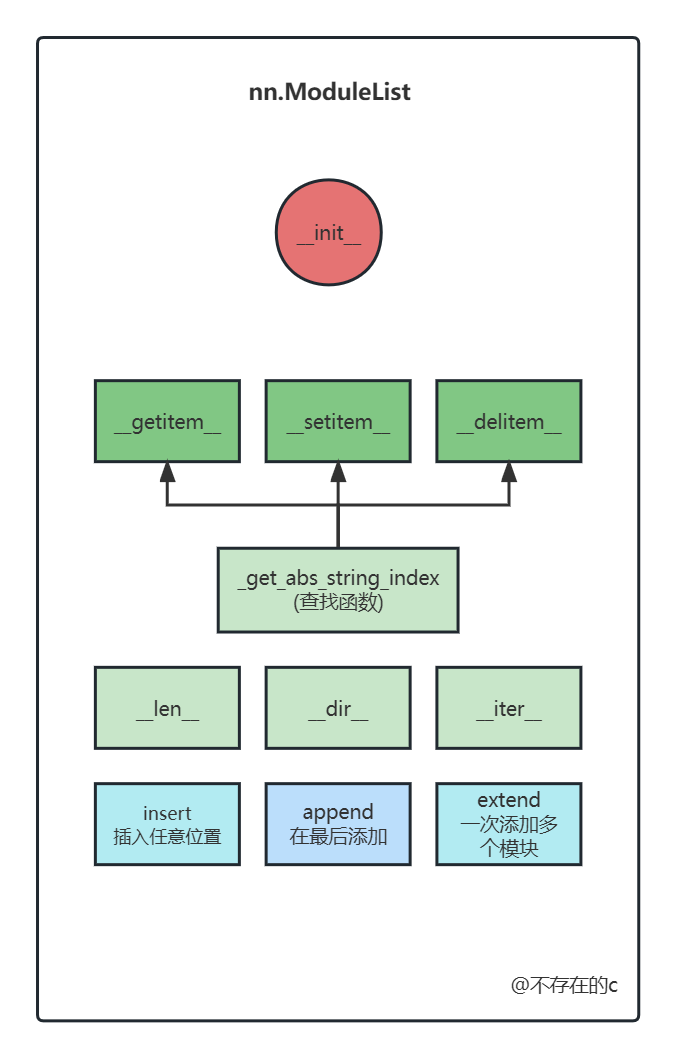
用法:
class MyModule(nn.Module):
def __init__(self):
super(MyModule, self).__init__()
# nn.ModuleList装了10个nn.Linear
self.linears = nn.ModuleList([nn.Linear(10, 10) for i in range(10)])
def forward(self, x):
# ModuleList can act as an iterable, or be indexed using ints
for i, l in enumerate(self.linears):
x = self.linears[i // 2](x) + l(x)
return x
这里只介绍insert/append/extend,其他函数与之前相同;
# insert 在任意位置添加
>>> linears = nn.ModuleList([nn.Linear(10, 10) for i in range(5)])
>>> linears
ModuleList(
(0): Linear(in_features=10, out_features=10, bias=True)
(1): Linear(in_features=10, out_features=10, bias=True)
(2): Linear(in_features=10, out_features=10, bias=True)
(3): Linear(in_features=10, out_features=10, bias=True)
(4): Linear(in_features=10, out_features=10, bias=True)
)
>>> linears.insert(3,nn.Conv2d(1,20,5))
>>> linears
ModuleList(
(0): Linear(in_features=10, out_features=10, bias=True)
(1): Linear(in_features=10, out_features=10, bias=True)
(2): Linear(in_features=10, out_features=10, bias=True)
(3): Conv2d(1, 20, kernel_size=(5, 5), stride=(1, 1))
(4): Linear(in_features=10, out_features=10, bias=True)
(5): Linear(in_features=10, out_features=10, bias=True)
)
# append 在最后添加
>>> linears
ModuleList(
(0): Linear(in_features=10, out_features=10, bias=True)
(1): Linear(in_features=10, out_features=10, bias=True)
(2): Linear(in_features=10, out_features=10, bias=True)
(3): Conv2d(1, 20, kernel_size=(5, 5), stride=(1, 1))
(4): Linear(in_features=10, out_features=10, bias=True)
(5): Linear(in_features=10, out_features=10, bias=True)
)
>>> linears.append(nn.Conv2d(1,20,5))
ModuleList(
(0): Linear(in_features=10, out_features=10, bias=True)
(1): Linear(in_features=10, out_features=10, bias=True)
(2): Linear(in_features=10, out_features=10, bias=True)
(3): Conv2d(1, 20, kernel_size=(5, 5), stride=(1, 1))
(4): Linear(in_features=10, out_features=10, bias=True)
(5): Linear(in_features=10, out_features=10, bias=True)
(6): Conv2d(1, 20, kernel_size=(5, 5), stride=(1, 1))
)
# extend 一次添加多个
>>> linears = nn.ModuleList([nn.Linear(10, 10) for i in range(3)])
>>> linears
ModuleList(
(0): Linear(in_features=10, out_features=10, bias=True)
(1): Linear(in_features=10, out_features=10, bias=True)
(2): Linear(in_features=10, out_features=10, bias=True)
)
>>> linears.extend([nn.Conv2d(1,10,5),nn.ReLU()])
ModuleList(
(0): Linear(in_features=10, out_features=10, bias=True)
(1): Linear(in_features=10, out_features=10, bias=True)
(2): Linear(in_features=10, out_features=10, bias=True)
(3): Conv2d(1, 10, kernel_size=(5, 5), stride=(1, 1))
(4): ReLU()
)
源码:
# 在任意位置插入一个模块
def insert(self, index: int, module: Module) -> None:
for i in range(len(self._modules), index, -1):
self._modules[str(i)] = self._modules[str(i - 1)]
self._modules[str(index)] = module
# 在最后添加一个模块
def append(self, module: Module) -> 'ModuleList':
r"""Appends a given module to the end of the list.
Args:
module (nn.Module): module to append
"""
self.add_module(str(len(self)), module)
return self
# 在最后添加多个模块
def extend(self, modules: Iterable[Module]) -> 'ModuleList':
r"""Appends modules from a Python iterable to the end of the list.
Args:
modules (iterable): iterable of modules to append
"""
if not isinstance(modules, container_abcs.Iterable):
raise TypeError("ModuleList.extend should be called with an "
"iterable, but got " + type(modules).__name__)
offset = len(self)
for i, module in enumerate(modules):
self.add_module(str(offset + i), module)
return self
3 nn.ModuleDict用法及源码
作用和nn.ModuleDict一样,一个是list形式,一个是dict形式;
将list的函数换成dict的函数即可;
函数们:
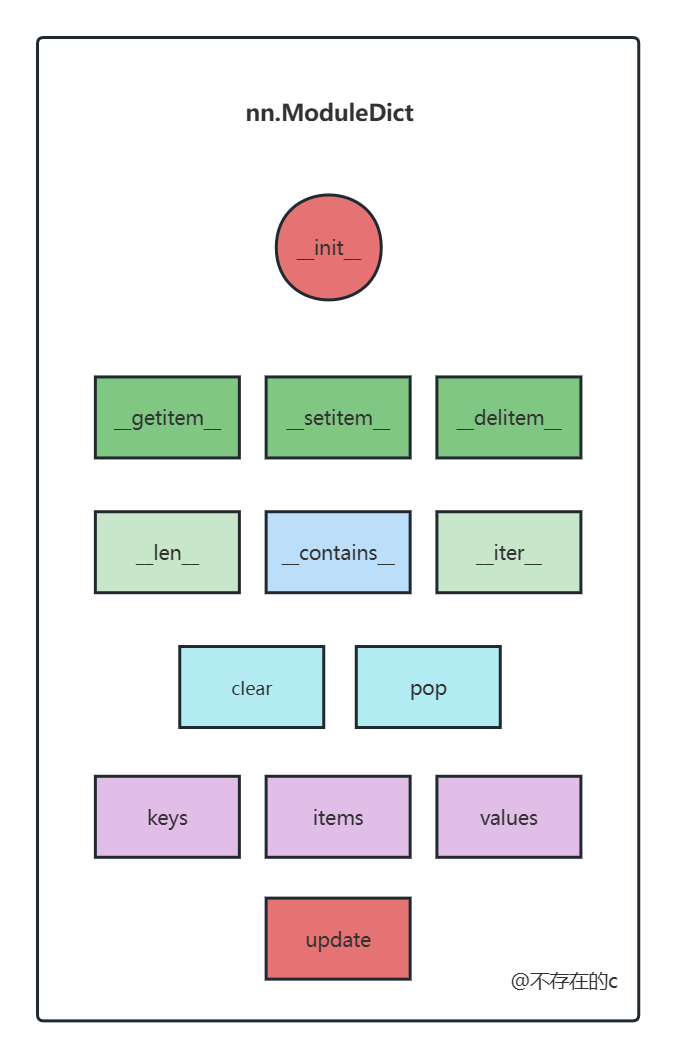
用法:
class MyModule(nn.Module):
def __init__(self):
super(MyModule, self).__init__()
self.choices = nn.ModuleDict({
'conv': nn.Conv2d(10, 10, 3),
'conv2': nn.Conv2d(10,10,3),
'pool': nn.MaxPool2d(3)
})
self.activations = nn.ModuleDict([
['lrelu', nn.LeakyReLU()],
['prelu', nn.PReLU()]
])
def forward(self, x, choice, act):
x = self.choices[choice](x)
x = self.activations[act](x)
return x
函数用法:
# 初始化一个ModuleDict
>>> choices = nn.ModuleDict({
... 'conv': nn.Conv2d(10, 10, 3),
... 'conv2': nn.Conv2d(10,10,3),
... 'pool': nn.MaxPool2d(3)
... })
>>>
>>> choices
ModuleDict(
(conv): Conv2d(10, 10, kernel_size=(3, 3), stride=(1, 1))
(conv2): Conv2d(10, 10, kernel_size=(3, 3), stride=(1, 1))
(pool): MaxPool2d(kernel_size=3, stride=3, padding=0, dilation=1, ceil_mode=False)
)
# 查看
>>> choices.items()
odict_items([('conv', Conv2d(10, 10, kernel_size=(3, 3), stride=(1, 1))), ('conv2', Conv2d(10, 10, kernel_size=(3, 3), stride=(1, 1))), ('pool', MaxPool2d(kernel_size=3, stride=3, padding=0, dilation=1, ceil_mode=False))])
# 只看键
>>> choices.keys()
odict_keys(['conv', 'conv2', 'pool'])
# 只看值
>>> choices.values()
odict_values([Conv2d(10, 10, kernel_size=(3, 3), stride=(1, 1)), Conv2d(10, 10, kernel_size=(3, 3), stride=(1, 1)), MaxPool2d(kernel_size=3, stride=3, padding=0, dilation=1, ceil_mode=False)])
# 更新现有的结构
>>> choices.update({'pool':nn.MaxPool2d(5)})
>>> choices
ModuleDict(
(conv): Conv2d(10, 10, kernel_size=(3, 3), stride=(1, 1))
(conv2): Conv2d(10, 10, kernel_size=(3, 3), stride=(1, 1))
(pool): MaxPool2d(kernel_size=5, stride=5, padding=0, dilation=1, ceil_mode=False)
)
# pop 删除一个
>>> choices.pop('pool')
MaxPool2d(kernel_size=5, stride=5, padding=0, dilation=1, ceil_mode=False)
>>> choices
ModuleDict(
(conv): Conv2d(10, 10, kernel_size=(3, 3), stride=(1, 1))
(conv2): Conv2d(10, 10, kernel_size=(3, 3), stride=(1, 1))
)
# 清空所有
>>> choices.clear()
>>> choices
ModuleDict()
源码:
class ModuleDict(Module):
def clear(self) -> None:
"""Remove all items from the ModuleDict.
"""
self._modules.clear()
def pop(self, key: str) -> Module:
r"""Remove key from the ModuleDict and return its module.
Args:
key (string): key to pop from the ModuleDict
"""
v = self[key]
del self[key]
return v
@_copy_to_script_wrapper
def keys(self) -> Iterable[str]:
r"""Return an iterable of the ModuleDict keys.
"""
return self._modules.keys()
@_copy_to_script_wrapper
def items(self) -> Iterable[Tuple[str, Module]]:
r"""Return an iterable of the ModuleDict key/value pairs.
"""
return self._modules.items()
@_copy_to_script_wrapper
def values(self) -> Iterable[Module]:
r"""Return an iterable of the ModuleDict values.
"""
return self._modules.values()
def update(self, modules: Mapping[str, Module]) -> None:
# 更新
if isinstance(modules, (OrderedDict, ModuleDict, container_abcs.Mapping)):
for key, module in modules.items():
self[key] = module
4 nn.ParameterList
函数们:
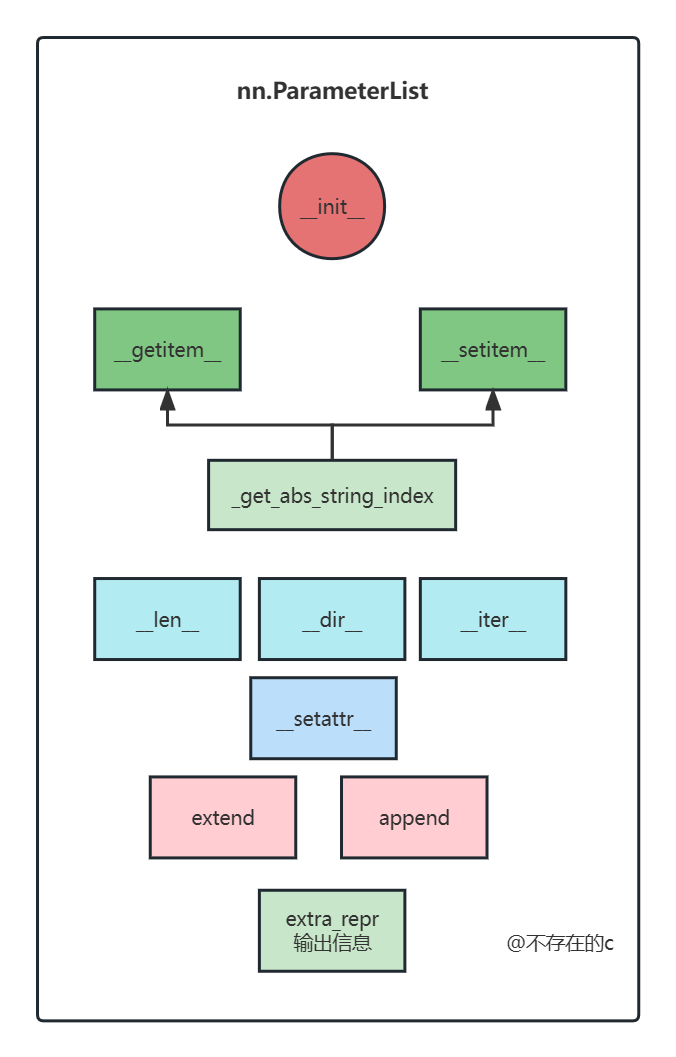
用法:
class MyModule(nn.Module):
def __init__(self):
super(MyModule, self).__init__()
self.params = nn.ParameterList([nn.Parameter(torch.randn(10, 10)) for i in range(10)])
def forward(self, x):
# ParameterList can act as an iterable, or be indexed using ints
for i, p in enumerate(self.params):
x = self.params[i // 2].mm(x) + p.mm(x)
return x
extra_repr函数
def extra_repr(self) -> str:
child_lines = []
for k, p in self._parameters.items():
size_str = 'x'.join(str(size) for size in p.size())
device_str = '' if not p.is_cuda else ' (GPU {})'.format(p.get_device())
parastr = 'Parameter containing: [{} of size {}{}]'.format(
torch.typename(p), size_str, device_str)
child_lines.append(' (' + str(k) + '): ' + parastr)
tmpstr = '\n'.join(child_lines)
return tmpstr
# 用法:
>>> params = nn.ParameterList([nn.Parameter(torch.randn(10, 10)) for i in range(10)])
>>> params.extra_repr()
' (0): Parameter containing: [torch.FloatTensor of size 10x10]\n (1): Parameter containing: [torch.FloatTensor of size 10x10]\n (2): Parameter containing: [torch.FloatTensor of size 10x10]\n (3): Parameter containing: [torch.FloatTensor of size 10x10]\n (4): Parameter containing: [torch.FloatTensor of size 10x10]\n (5): Parameter containing: [torch.FloatTensor of size 10x10]\n (6): Parameter containing: [torch.FloatTensor of size 10x10]\n (7): Parameter containing: [torch.FloatTensor of size 10x10]\n (8): Parameter containing: [torch.FloatTensor of size 10x10]\n (9): Parameter containing: [torch.FloatTensor of size 10x10]'
5 nn.ParameterDict
函数们:
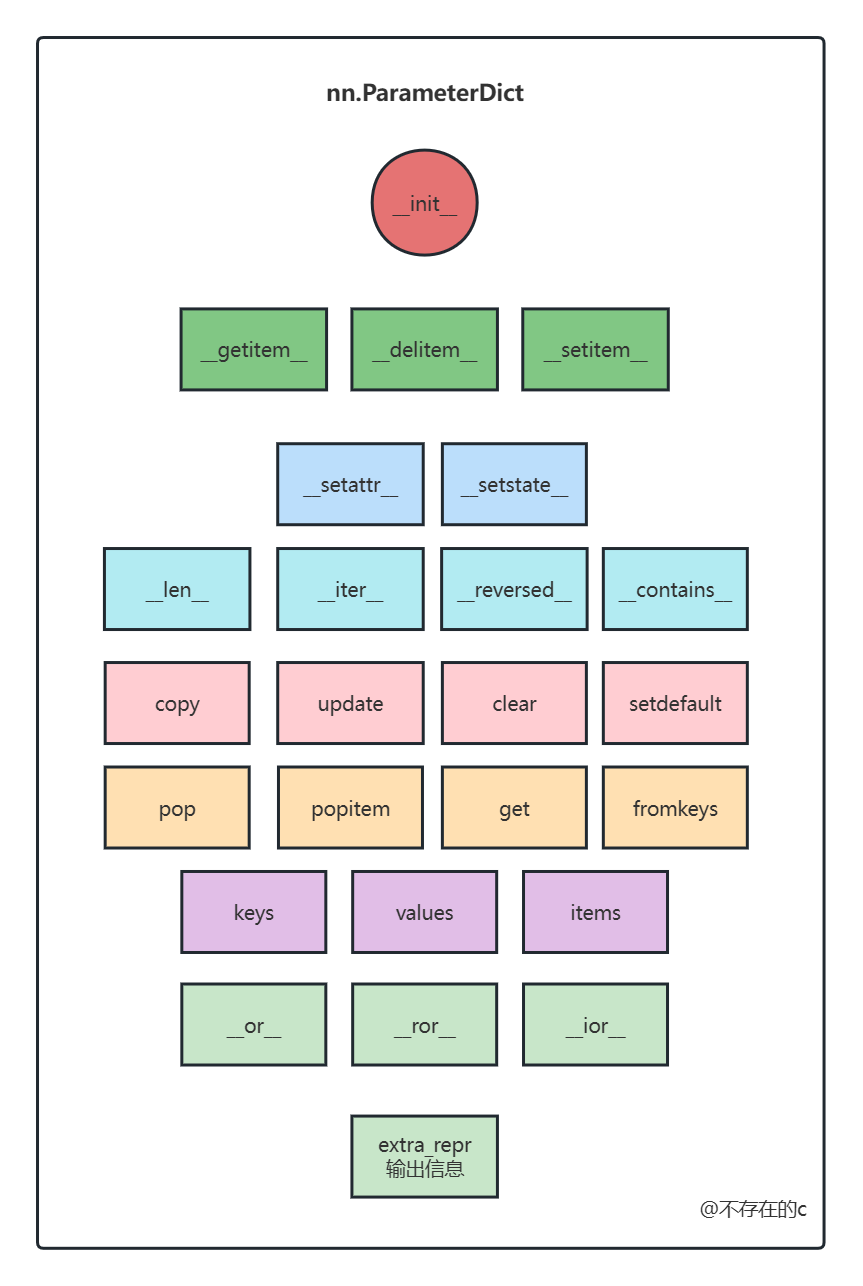
用法:
class MyModule(nn.Module):
def __init__(self):
super(MyModule, self).__init__()
self.params = nn.ParameterDict({
'left': nn.Parameter(torch.randn(5, 10)),
'right': nn.Parameter(torch.randn(5, 10))
})
def forward(self, x, choice):
x = self.params[choice].mm(x)
return x




















 1774
1774











 被折叠的 条评论
为什么被折叠?
被折叠的 条评论
为什么被折叠?








